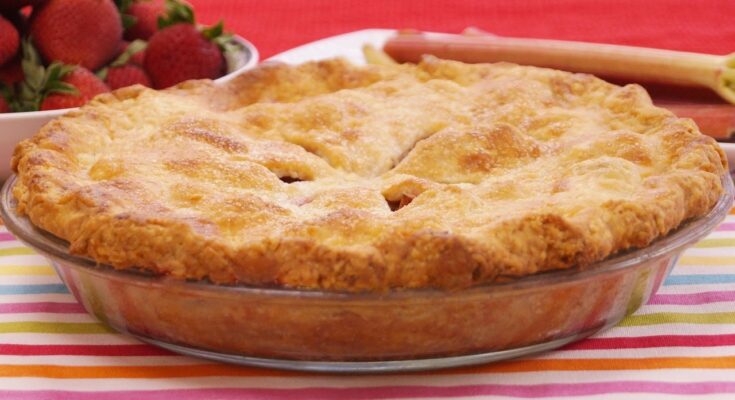Pie Pie Crust Recipe: Let’s be honest—nailing the perfect pie crust can feel like kitchen sorcery. But the truth is, it all comes down to understanding the process. A buttery, flaky crust is the backbone of any great pie. Whether you’re making apple, pumpkin, or a savory quiche, the crust is the unsung hero that holds it all together—literally.
There’s a big difference between store-bought and homemade pie crust. Sure, the ready-made ones are convenient, but they usually come with a bland flavor and stiff texture. A homemade crust, on the other hand, is tender, crumbly, and packed with rich, buttery flavor. It adds character to your pie and elevates the entire dish from average to unforgettable.
We’re going to walk through the entire pie crust-making process, step by step, with all the tips, tricks, and kitchen hacks you’ll need. No more cracked crusts, soggy bottoms, or dough stuck to your counter. Let’s dive into the flaky, golden world of homemade pie crust perfection.
Ingredients You’ll Need
Let’s start with the essentials. Pie crust is a minimalist’s dream. You only need a handful of ingredients, and you probably already have most of them in your kitchen.
Basic Ingredients Breakdown
- All-purpose flour (2 ½ cups): The foundation of your crust. Stick with unbleached if possible.
- Unsalted butter (1 cup or 2 sticks): Cold and cubed. This gives your crust that signature flakiness and buttery flavor.
- Salt (1 teaspoon): Enhances flavor.
- Ice water (6–8 tablespoons): Keeps the fat cold and helps the dough come together without making it sticky.
Optional Add-ins for Flavor and Texture
- Sugar (1 tablespoon): Optional, but great for sweet pies.
- Vinegar or vodka (1 tablespoon): Helps prevent gluten development, which can make your crust tough.
- Lard or shortening (substitute half the butter): Some bakers swear by this for added tenderness.
The key to all these ingredients? Temperature. You want everything cold. Room-temperature butter or warm water can sabotage the whole process before you even get started.
Tools and Equipment
You don’t need a fancy kitchen setup to make a great pie crust, but having the right tools can make your life a whole lot easier.
Must-Have Kitchen Tools
- Mixing bowl: For combining your ingredients.
- Pastry cutter or forks: To cut the butter into the flour.
- Measuring cups and spoons: Accuracy matters.
- Rolling pin: To roll out the dough evenly.
- Plastic wrap: For chilling the dough.
Nice-to-Have Extras
- Food processor: Speeds things up and ensures even distribution.
- Pastry mat or parchment paper: Prevents sticking and makes cleanup easier.
- Pie weights or dried beans: Essential for blind baking.
Having these tools handy means fewer obstacles between you and the pie of your dreams.
Step-by-Step Guide to Making Pie Crust
Let’s break down the process into manageable steps. Each part plays a critical role in achieving a flaky, golden-brown crust.
Step 1: Measure Your Ingredients Precisely
This isn’t the time for eyeballing. Use proper measuring cups and level off the flour. Too much or too little flour can throw off the entire texture of your crust.
Make sure the butter is cold. I’m talking straight-from-the-fridge cold. Some bakers even freeze their butter and grate it into the flour. Why? Because the goal is to keep chunks of fat intact—those chunks melt during baking and create steam pockets, which give your crust its signature flakiness.
Step 2: Cut the Fat into the Flour
Add your cold butter (and/or lard) into the flour. Use a pastry cutter or two forks to break the butter into pea-sized pieces. This part takes a few minutes, but don’t rush it. The idea is to coat the flour with fat without melting it.
This step is where the magic begins. You’re building the crust’s structure, and those little bits of butter are going to make your pie puff and flake like a dream.
Step 3: Add Ice Water Slowly
Start with 6 tablespoons of ice water. Drizzle it in a tablespoon at a time while gently tossing the dough with a fork. If the dough looks dry, add another tablespoon. Stop as soon as the dough starts clumping together. Don’t add too much water—it should look shaggy, not sticky.
Step 4: Form the Dough Into a Disc
Gently press the dough together into a ball without kneading it. Divide it in half if you’re making a double crust. Flatten each half into a disc about 1 inch thick. Wrap tightly in plastic wrap.
This step preps the dough for rolling and prevents it from cracking around the edges.
Step 5: Chill the Dough
Pop your wrapped dough in the fridge for at least 1 hour. Chilling lets the gluten relax and the butter firm back up. It’s a patience game, but trust me—it makes all the difference.
Rolling and Shaping the Crust
Alright, your dough is chilled and ready—time to roll! This part can be intimidating, but with the right technique, you’ll roll out a flawless crust every time.
Tips for Rolling Without Sticking
Take the dough out of the fridge and let it rest at room temperature for about 5–10 minutes before rolling. This makes it pliable and easier to work with. Lightly flour your surface and rolling pin to prevent sticking, but don’t overdo it. Too much flour can dry out your dough.
Roll from the center outward, rotating the dough a quarter turn every few rolls to maintain a circular shape. Try to keep an even thickness—about ⅛ inch is the sweet spot for most pies.
If the dough cracks, don’t panic! Press it gently back together or patch it with a little dough scrap. It’s rustic, not ruined.
How to Transfer the Dough to Your Pie Pan
Now the tricky part: moving the dough without tearing it. You can either gently fold the dough in half and lift it into the pie pan, or roll it loosely around your rolling pin and unroll it over the pan.
Gently ease the dough into the pan—don’t stretch it, or it’ll shrink while baking. Press it lightly against the bottom and sides, and trim the overhang to about ½ inch beyond the edge of the pan. Fold the overhang under itself and crimp the edges with your fingers or a fork.
Voilà! You’ve just lined a pie pan like a pro.
Pre-Baking (Blind Baking) the Crust
Some pies require a fully or partially baked crust—especially if the filling doesn’t need much bake time. This is where blind baking comes in.
When and Why to Blind Bake
If you’re making a cream pie, lemon meringue, or any custard-based pie, blind baking is non-negotiable. It ensures the crust gets golden and crisp rather than soggy and raw beneath your filling.
You’ll also want to blind bake if you’re using a no-bake filling or if your filling takes less time to cook than the crust.
How to Blind Bake Perfectly
After fitting your dough into the pan, line it with parchment paper or aluminum foil. Fill it with pie weights, dried beans, or even rice—anything that will keep the dough from puffing up or shrinking.
Bake at 375°F (190°C) for about 15–20 minutes. Then, carefully remove the weights and lining and bake for another 5–10 minutes, or until the crust is lightly golden. For a fully baked crust, keep it in until it’s deep golden brown, around 30–35 minutes total.
Let it cool before adding your filling. Crispy, golden, and ready to shine.
Baking Tips and Tricks
Even the most experienced bakers run into pie crust issues. These tips will keep your crust looking and tasting fantastic.
Preventing a Soggy Bottom
This is the bane of pie-making! But it’s fixable.
- Always preheat your oven.
- Use a glass or metal pie dish—they conduct heat better than ceramic.
- Brush the crust with a beaten egg white before adding the filling to create a moisture barrier.
- Place your pie on the lowest oven rack or even a preheated baking sheet for an extra boost of bottom heat.
How to Get a Golden, Flaky Finish
A flaky crust comes from cold fat and minimal handling. But that golden, glossy finish? That’s all about the egg wash.
Before baking, brush the crust with a mix of one beaten egg and a tablespoon of milk or water. This adds color and shine, making your crust look as good as it tastes.
Want extra crunch? Sprinkle a little sugar (for sweet pies) or flaky salt (for savory) on top after the wash.
Common Mistakes and How to Avoid Them
We’ve all had a crust disaster—cracking, shrinking, tough texture. Here’s how to avoid the common pitfalls.
Overworking the Dough
This is a biggie. The more you knead or mix, the more gluten develops. While gluten is great in bread, in pie crust it leads to toughness. Mix only until the dough comes together, and no more.
Using Warm Ingredients
Butter should be cold. Water should be icy. Your hands? Preferably not too warm either. If things get too soft, chill your dough again before proceeding. Cold fat = steam = flaky layers.
Also, don’t skip chilling between steps. Resting the dough relaxes the gluten, which helps prevent shrinking in the oven.
Variations on the Classic Pie Crust
Not every crust is created equal. Depending on what you’re baking, you might want to experiment with different fats or dietary alternatives.
All-Butter vs. Shortening vs. Lard
- All-butter: Rich flavor, excellent flakiness. A bit trickier to handle.
- Shortening: Very easy to work with, produces a tender crust, but lacks flavor.
- Lard: Super flaky, amazing for savory pies. A combo of butter and lard is often the best of both worlds.
Gluten-Free and Vegan Options
For a gluten-free crust, use a 1:1 gluten-free flour blend and add a binding agent like xanthan gum. For vegan crusts, sub the butter with solid coconut oil or vegan butter. You may need to tweak your chilling and rolling technique to match the fat’s texture.
Best Fillings for Your Homemade Pie Crust
Now that you’ve mastered the crust, what goes inside? A homemade pie crust can handle just about anything you throw at it, sweet or savory. Here are some mouthwatering ideas to inspire your next baking session.
Sweet Fillings
If dessert is your jam (pun intended), you’re in for a treat. Sweet pies are where a buttery, flaky crust truly shines.
- Classic Apple Pie: Thinly sliced apples, cinnamon, sugar, and a dash of nutmeg.
- Pumpkin Pie: Creamy, spiced pumpkin custard in a blind-baked shell.
- Pecan Pie: Sticky, nutty, and rich—perfect for holidays.
- Berry Pies: Blueberries, raspberries, strawberries—fresh or frozen.
- Chocolate Cream Pie: Silky chocolate filling topped with whipped cream.
Tip: For juicy fruit pies, mix a tablespoon of cornstarch or flour into your filling to prevent excess liquid from soaking your crust.
Savory Fillings
Not in the mood for sweets? No problem. This crust is just as perfect for a savory main course.
- Quiche Lorraine: Eggs, cream, bacon, and cheese baked into a blind-baked shell.
- Chicken Pot Pie: Creamy chicken and veggie filling in a hearty crust.
- Tomato and Cheese Tart: Layers of fresh tomato, mozzarella, and herbs.
- Spinach and Feta Pie: Like spanakopita but in a sturdy crust.
These savory options are great for brunches, lunches, or dinner with a twist.
Storage and Make-Ahead Tips
Life gets busy, but good news—pie crust is one of those things you can prep ahead and stash for later. Whether you’re making a double batch or saving leftovers, here’s how to keep your dough fresh and ready to roll.
How to Freeze Pie Dough
Wrap your pie dough disc tightly in plastic wrap, then place it in a resealable freezer bag. Label it with the date and type of crust (butter, vegan, etc.). It will last up to 3 months in the freezer.
When you’re ready to use it, thaw in the refrigerator overnight. Don’t microwave or leave it on the counter—slow thawing preserves the texture.
You can also freeze a fully rolled-out crust in the pie pan. Just wrap it tightly in foil and freeze. Great for prepping holiday pies!
How Long It Lasts
- In the fridge: Wrapped pie dough will stay good for up to 3 days.
- In the freezer: Well-wrapped dough or unbaked crusts can be frozen for 2–3 months.
- Baked crust: Store blind-baked crusts at room temp for a day or in the fridge for up to 3 days.
Pro tip: If you’re baking often, make a few batches at once and store them. Your future self will thank you.
FAQs about Pie Pie Crust Recipe
Q1: Can I use butter instead of shortening in my pie crust?
Yes, you can substitute butter for shortening. Butter adds a rich flavor, while shortening gives a flakier texture. For the best of both worlds, many bakers use a mix of both.
Q2: Why does my pie crust shrink during baking?
Shrinking often occurs when the dough is overworked or not chilled properly. Make sure to let the dough rest in the fridge for at least 30 minutes before rolling it out and avoid stretching it when fitting it into the pie dish.
Q3: How do I make my pie crust extra flaky?
The secret to a flaky crust is keeping your ingredients cold, especially the fat. Use chilled butter or shortening, and handle the dough as little as possible to prevent the fat from melting before baking.
Q4: Can I freeze pie dough for later use?
Absolutely! Wrap the dough tightly in plastic wrap and freeze for up to 3 months. Thaw overnight in the refrigerator before rolling it out.
Q5: What’s the best flour to use for pie crust?
All-purpose flour works best for most pie crusts. It strikes the right balance between structure and tenderness, making it ideal for both sweet and savory pies.
Final Thoughts
Mastering a homemade pie crust is one of those baking skills that seems intimidating at first—but once you get it, you’ll never go back to the store-bought stuff. From flaky layers to buttery richness, there’s just no comparison.
And like anything worthwhile in the kitchen, it takes practice. Your first crust might tear, your second might shrink, but by your third or fourth, you’ll be rolling dough like a seasoned baker. Keep your ingredients cold, your hands light, and your patience strong.
At the end of the day, it’s not just about making a crust—it’s about making memories. Whether you’re baking for a holiday, a potluck, or just because, a homemade pie always brings smiles. So roll up your sleeves, preheat that oven, and get baking. Your perfect pie awaits.



